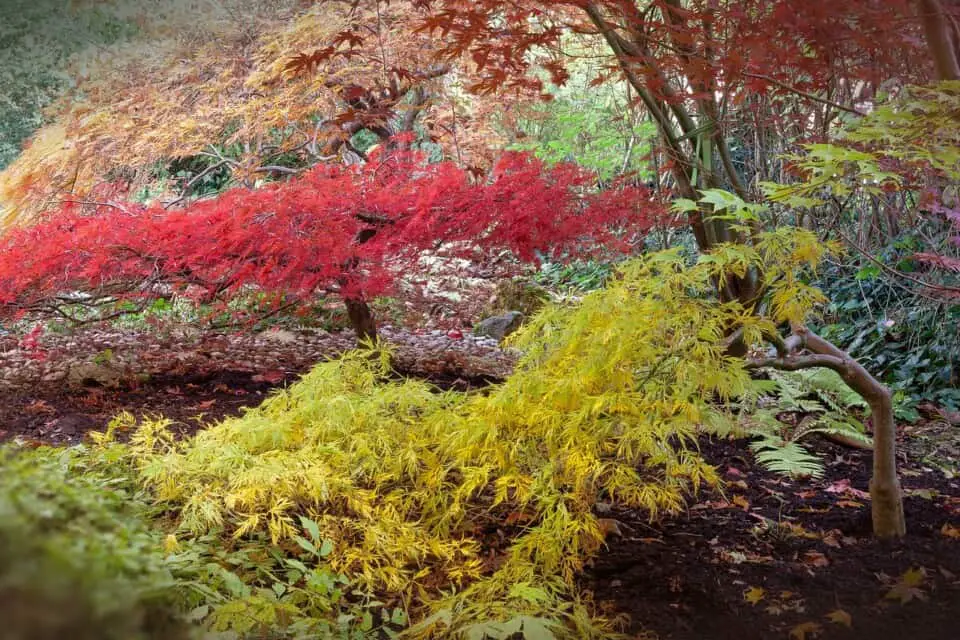Some links in the post are affiliate links and I get a commission from purchases made through some links found in the post.
Falling in love with acer trees is effortless. Start with the fact that they look great in landscaping.
If you’re looking for the final touch to your garden, which can serve as a focal point, you cannot go wrong with these trees.
They feature green and red leaves, which turn orange, yellow, and purple in the fall. So, as other people dismay at the falling of leaves in the fall, you’d be gasping at the beautiful sight in your garden.
Are you sold yet? My second point is just as good. These beautiful trees bloom in the spring. That’s right! On top of having beautiful foliage, they also produce flowers which are small, radiant, and fitting for this tree.
There possibly couldn’t be more to add to this tree, could there? Here comes the third point – they give rise to fruits known as samaras.
These measure about half an inch and are a fitting end to the flowering process. I should also add that you can eat the acer tree leaves. And that makes it one of the most perfect species you will ever come across.
So, to see your tree dying can be one of the most disheartening things you can go through as a gardener.
The reasons your acer tree could be dying could be exposure to strong winds, too much sun, too much water, not enough water, your acer has too many or not enough nutrients and the soil is too alkaline.
But the good news is that you can stop this death in its tracks by understanding why your tree is no longer thriving and fixing the problem. This guide takes you through this and more:
Why Is My Acer Tree Dying and How Can I Fix It?
Did you know that acer trees are commonly known as Japanese maple trees? Acer is the standard term as it relates to the botanical name acer palmatum.
Thus, when I talk of the acer tree and its issues, you can relate this to the varieties under this nomenclature. So, what are the common reasons that lead to the death of this magnificent tree?
1) Exposure to Strong Winds
The acer tree may appear strong, but it is quite delicate when it comes to strong winds. If you position the tree in a spot that receives direct winds, you leave it exposed to increased water loss from its leaves.
After all, the plant is native to forests where it grows under canopies. So, it rarely needs to withstand windy conditions because the species around it block most of the impact.
How to Protect Your Acer Tree
To keep your tree hydrated and protected, you should:
1) Ensure it has adequate access to water
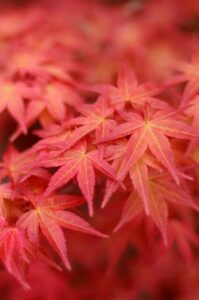 Strong winds rob the tree’s leaves of moisture, leaving it dehydrated and prone to drying and browning.
Strong winds rob the tree’s leaves of moisture, leaving it dehydrated and prone to drying and browning.
But if you keep feeding the tree with moisture, its roots can absorb enough water to replenish what its leaves have lost to the atmosphere.
So, how much water should you give your acer tree? Young plants are more likely to suffer the effects of wind exposure. In this case, you should deeply soak the zone around the roots using a bucket of water.
That should reach about a foot into the soil. Also, if the soil feels particularly dry, do not hesitate to water the tree as it needs this moisture to establish in the ground.
For older plants, you can sprinkle some water around the roots whenever the ground feels dry.
2) Add a windbreaker
An easy way to protect your acer tree is to replicate the canopy effect it would enjoy in its native habitat. And you do this by attaching a frost cloth to the top of the tree.
However, this might not work for young plants as the cloth might be too heavy for the tree. You might want to attach it to a taller structure near the tree to have a similar effect.
Alternatively, you can plant more trees or shrubs around the acer tree to provide more cover. Please note that this cover is not always necessary as keeping the tree hydrated and adding a frost cloth should be adequate.
2) Exposure to Too Much Sun
Did you know that acer trees can also suffer from sunburn? These trees grow in shaded conditions where they rarely access direct sunlight.
Thus, the minute you expose their leaves and trunks to the sun’s rays, you start noticing signs of leaf scorch where the leaves turn brown. But what causes this?
It comes about when the areas between the leaf margins and veins start dying because they are damaged by the sun. And when this happens, the plant can no longer make enough food to support its growth.
Dealing with Leaf Scorch
Foliage damage is irreversible, and unfortunately, it takes away your tree’s ability to sustain its growth. Usually, when leaf scorch is extensive, the tree’s growth stunts and its leaf production reduces.
Ultimately, this also affects how much (and if) it flowers. As such, it’s best to deal with the problem head-on before it gets worse. How do you do this?
1) Ensure the plant has access to filtered sun
also known as bright and indirect light or dappled light. The idea here is to ensure there is a barrier between the sun and the tree such that minimal direct light gets to the tree.
You can also refer to this type of light as partial shade. The acer tree does not need much light to make food, and this would prove to be sufficient.
Some species will even grow in full shade, especially when you live in the higher USDA zones. So, please check what is most suitable for your plant and provide it with the same.
2) Avoid the afternoon sun
Your plant will still have access to some light in its position. The morning sun is relatively gentle and often does not result in any sun damage.
But this can change in some regions where even the morning sunshine tends to be quite hot. Midday sun and afternoon sun are often too hot for the tree to tolerate.
So, it’s best to locate your plant towards the east of the garden, where it receives only morning sun and does not get more access after that.
3) Shade the plant
If your plant lies towards the west or south of your garden, it will receive bright and direct sun rays, which can damage its leaves. Thus, you can either move the plant or provide it with some shade to obstruct the direct rays.
4) Water the plant
Most foliage damage occurs in the summer when the transpiration rates increase. You should water your plant enough to ensure that its leaves are hydrated enough to withstand the high temperatures.
5) Mulch the tree
Another easy way to help the tree conserve moisture is to add a layer of mulch around its base. Keep it at one inch at most to avoid creating an environment in which disease-causing organisms can find a place to live.
6) Move the plant
If all the above methods are not feasible because the plant is towards the east or south of the garden, consider moving it. Sun damage does not just affect the tree’s leaves but its trunk and branches too.
So, if it’s in an exposed spot, you would spend a lot of time protecting it and might lose out on its visual appeal. How about positioning it to the east?
Soon enough, the plant should recover, and you can stop seeing unsightly browning leaves on its façade.
You may also like: Where should you plant a Japanese maple tree
3) Your Plant Has Too Much Water
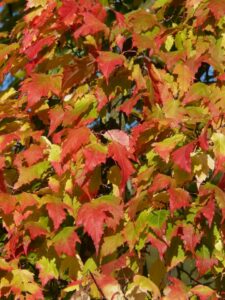 When dealing with sun and wind damage, you may have noticed a heavy reliance on watering. Yes, your acer tree will need watering to deal with the elements.
When dealing with sun and wind damage, you may have noticed a heavy reliance on watering. Yes, your acer tree will need watering to deal with the elements.
But too much watering might set your tree back and even kill it. So, why does this happen, and where should you draw the line?
Acer trees like being in moist and well-draining soil with a slightly acidic pH. Thus, any of the conditions below can result in overwatering and could lead to verticillium wilt or root rot:
- Watering the plant when the soil is not dry,
- Planting the tree in a location where the soil has a high clay content, and
- Leaving the tree in a pot with few or blocked drainage holes.
Dealing with Overwatering
When your acer tree sits in water for too long, its roots start drowning in the water. Moreover, the reduced access to oxygen paves the way for fungal pathogens that attack the plant.
Such a plant will show signs of yellowing and greying in its leaves. Its leaves may also start curling and drooping, signifying that the tree no longer has access to adequate moisture and nutrients – this owes to compromised root systems.
So, what’s the best way to save your tree? First, you must check if the tree has suffered root rot because of the overwatering and proceed as follows:
a) An Overwatered Acer Tree
If your plant has been in water for too long and its roots have started drowning, it will exhibit yellowing and browning in its leaves. The soil may also appear soggy but will not have a foul smell. In this case, you can proceed by:
1) Not watering the plant for a week or two to allow the plant to use the water in the ground. Allow the plant to remain this way until the soil dries.
Once the top inches of the soil are dry to the touch, start watering it again, ensuring that you only do so when the soil is dry.
It’s always good to invest in a moisture gauge that can help you know when to add water and when to let the plant survive on rainfall.
2) Amending the soil around the tree: If the soil does not start drying immediately after you withdraw watering, the issue could be the soil. And often, this comes about when the soil has a fine texture like that of clay.
To fix this, incorporate materials with a coarse texture like sand. These will result in a medium texture soil mix akin to that in loam soils and will allow the water to pass easily while maintaining enough moisture for the tree.
3) Moving the plant to a better pot: Suppose you grow your acer tree in a pot. You will need to check if the pot has enough drainage holes or whether the plant ends up sitting in water because the excess water does not drain.
If the case is the latter, you will need to invest in a pot with better drainage.
4) Transplanting the acer tree: Sometimes, you may have planted the acer tree in a section where the soil is so fine that amending it won’t work. You can move it to another location, ensuring that the new spot is well-shaded.
It takes about a week or two to see the results of the above changes.
b) An Acer Tree with Root Rot
If the tree has been sitting in water for too long, fungal pathogens may have already attacked it. Such a plant will also show signs of wilting and yellowing, and the soil around the base will be moist.
Furthermore, the soil will have a foul smell, indicating that fungal action has started. How can you deal with this?
1) Dig up the acer tree and inspect the extent of the damage. Unfortunately, dealing with root rot is often complicated if the damage is higher than 50% of the roots. However, you can always try to save your plant.
2) Leave the plant out to dry and cut out the infested parts using sharp and clean tools. Then apply fungicide to the remaining root sections and move the tree to a new spot with well-draining soil.
You should then follow up with the proper watering schedule to ensure that the plant does not suffer the same fate again.
Please note that it could be weeks before the plant recovers enough after the transplanting. At this time, you will need to water it moderately and shade it from the sun to prevent sunburn.
If the damage is higher than 50%, it is best to discard the plant by burning it so you can kill the pathogens. Then use fungicide on the soil to ensure no pathogens remain in it.
That way, when you plant another acer tree, you can avoid dealing with this issue again.
Even if you decide to save the plant and move it to another spot, you should still treat the original location with fungicide. Lightning can strike twice in this case.
You may also like: Top 5 best small trees with non invasive roots
4) Your Plant Does Not Have Enough Water
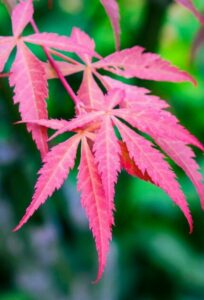 An underwatered acer tree will show signs of yellowing, just like you would see in an overwatered tree. But there is a difference.
An underwatered acer tree will show signs of yellowing, just like you would see in an overwatered tree. But there is a difference.
When dehydration is to blame, the tree starts by wilting. And when you do not water it in time, the leaves start yellowing and falling off. If the weather is hot, the leaves can also turn brown.
What causes underwatering? Your tree relies on moisture to photosynthesize and make enough food to grow bigger. And as it does this, it also loses water to the environment via transpiration. S
o, it absorbs more water from the ground to keep up with this water loss and continue with cellular activities.
But when it does not have access to water, it starts losing water without replenishing it, causing a shortage that halts most cellular activities.
The plant tries to reduce the evaporation rates by wilting and reducing the surface area exposed to the sun and wind. But this can only work for so long.
And if you do not water it, the leaves start losing their chlorophyll as the plant begins reserving its energy by draining what’s on the healthy leaves. Thus, the wilt soon becomes a loss of color (hence the yellowing), followed by leaf loss.
Can You Fix Underwatering?
Underwatering is probably one of the easiest issues to deal with in acer trees. After all, once you give your plant access to moisture, it will perk up in no time. Use the following measures:
- Follow a consistent watering schedule: Your tree should always have access to moisture. And when it gets hotter, this need will increase. You should check how dry the soil feels and water it each time the top inches are dry to the touch.
- If the soil drains water too fast, you can amend it with fine-textured materials like clay to increase its water retention rate. Otherwise, you will end up watering the plant more than you should.
- Mulch the base of the plant using materials an inch thick. This mulch will also serve as nutritional input as the organic materials break down over time.
- Increase the shade around the plant: Where your acer tree is exposed to sun and wind, you will often deal with underwatering regardless of how often you water the plant. Adding some shade or moving the plant to a cooler spot can save you a lot of trouble.
Will the leaves be back to normal? Wilted leaves only droop to reduce the evaporation rates. At this point, minimal damage has occurred.
And once you provide the tree with moisture, the leaves will soon look healthy. But yellowed and browning leaves have already suffered changes that you cannot reverse by feeding the plant with water.
Worry not, as your tree will soon produce enough healthy leaves to overshadow the affected ones.
5) Your Tree Has Too Many Nutrients
At this point, you may have noticed that most issues facing your tree result from two extremes – you are either giving it too much or too little of something.
Isn’t it interesting how most of these problems come about due to the lack of balance? Let’s consider how this applies to feeding your plant.
Acer trees are light feeders that can do well in compost-amended soil without commercial feeds. In fact, you should not even feed them until they are at least a year old.
And even then, you should limit the feeding to early spring as needed. However, gardeners often try to coax their trees to grow bigger by adding some inputs.
And there is nothing wrong with that as long as you consider the feeding habits of this particular tree.
When you give it more than it needs, you start seeing signs of yellowing or browning leaves that result from root damage. Or the plant develops soft and long stems that droop. And in worst-case scenarios, the plant dies.
What Can You Do?
The most important thing to keep in mind is that your tree can do without fertilizer. Of course, potted trees will need input now and then, lest they die.
But for trees grown in the ground, an annual feed should be enough. You can even stick to a feeding schedule with a two-year-spacing.
What should you do to revive an overfertilized plant?
- Stop feeding the plant: There is not much you can do to save the plant but be patient. Some people attempt to move the plant. And while this is a good choice, it’s not always necessary unless the plant has suffered significant root damage and the soil has a high input content.
- Give the plant a year to recover. During this time, you can cut out all commercial feeds. The plant can still benefit from the mulch on its base and leftover nutrients.
- Assess the surrounding plants: Sometimes, the extra nutrients may result from feeding other plants. You should consider how much fertilizer you are offering other plants as this eventually makes its way to the plants in the vicinity.
When you start feeding your plant, stick to a slow-release and multi-purpose feed diluted to half its strength. Or play it safe by using compost and other organic feeds with a slow absorption rate.
6) The Soil is Too Alkaline
Acer trees prefer slightly acidic soil with a pH of about 5.5 to 6.5.
If your plant is showing signs of slowed growth or seems to be dying, the plant may be suffering from chlorosis – this is a condition where the plant is unable to take up nutrients owing to unsuitable growing conditions.
Moreover, the plant may be unable to make chlorophyll, further hampering its ability to grow healthy leaves and stems.
Dealing with Chlorosis
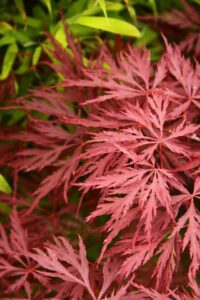 If you suspect that the tree may be in poor soil conditions, you should test it using a pH testing kit. If the range is between 5.5 and 6.5, another issue is to blame.
If you suspect that the tree may be in poor soil conditions, you should test it using a pH testing kit. If the range is between 5.5 and 6.5, another issue is to blame.
You can also tell by whether other acid-loving plants are doing well in the garden. If they are, the soil should be good enough for the acer tree.
But if the soil has a range above this, the soil will require amendment. You can add acidic implements like coffee grounds to make the soil more acidic.
Keep testing it and amending it until you get the suitable range. For lower levels, you will need to add alkaline materials like ash to raise the pH. Using organic feeds like compost will eventually help the soil retain the required range.
You can also transplant the acer tree and move it to a pot where you will have more say over its soil conditions.
Final Thoughts
Acer trees do pretty well in USDA hardiness zones 5 to 9. And if they get the proper care (watering, light, and nutrients), they can grow up to 25 feet (7.5 meters) tall and wide. Now that’s a feature for any landscape!
Happy Gardening!

